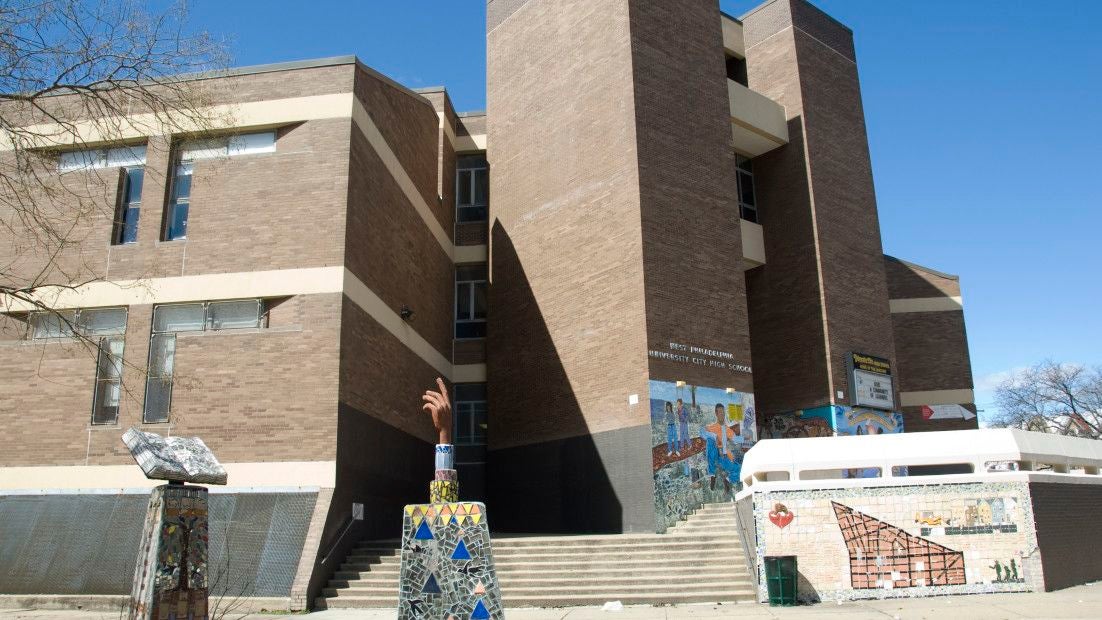Hurried negotiations over redevelopment of University City High

Negotiations continued over the weekend between representatives of Drexel University and a number of community organizations regarding the zoning of the former University City High School property, which sits on a 14-acre parcel bounded roughly by 36th and 38th streets, Filbert Street and Lancaster Avenue.
Drexel has an agreement with the Philadelphia School District to purchase the property for $25 million, and it says it plans to invest a total of nearly $1 billion tearing down existing buildings and developing a mix of uses on the property.
Its plan—the details of which haven’t been released—would involve commercial, residential, and institutional uses and provide 3,700 full-time permanent jobs, the university estimates. It may also involve the development of a K-8 public school.
While the plans haven’t been finalized, Drexel says it needs a new zoning designation in place before it completes the purchase of the property, which is scheduled to close on June 16.
A bill that would upzone the property to CMX-4, a high-density commercial mixed-use category, was subject to a hearing in Council’s Committee on Rules last week, but was held at the request of its sponsor, Councilwoman Jannie Blackwell. Blackwell accused Drexel of failing to negotiate in good faith with her office and local community groups.
The hearing on that bill will continue Monday afternoon, at 3 p.m.
“We need clear assurance that the zoning of the property will be done in a way that will allow us to proceed with our anticipated development concepts prior to our closing on the 16th of June,” said Peter Kelsen, an attorney representing Drexel, on Friday afternoon.
“Our sleeves have been rolled up and we’re trying to figure out a consensus plan,” he added.
Michael Jones, president of Powelton Village Civic Association, said on Saturday that his group and others have concerns about the height of the new development on portions of the block that face small-scale housing. He also said that since the development of the K-8 school—which the community supports—isn’t a sure thing, residents want assurances that portions of the site won’t be sold off with the higher zoning designation to a less responsive owner.
“[Drexel] would like to be able to do everything on the site by right, and that’s fine, but they’re proposing a CMX-4-plus zoning for the site,” Jones said. “That means that, were portions of the site to sell to somebody else, we need some kind of underlying agreement … that would continue to restrict what could be built on those portions of the site on the north end that really need to respect the neighborhood.”
The current draft of the bill caps the height of the building at 75 feet along certain edges of the property, and at 120 feet further in. Jones said that even 75 feet would be vastly out of scale with the surrounding neighborhood on certain portions of the site. His group has accepted that the site is going to be densely developed, but wants to “massage development into places on the site that it isn’t out of context with the neighborhood.”
He said Drexel is in agreement, conceptually, but the details are still under negotiation.
A deal is likely to be worked out Monday afternoon, but the tenuous negotiations raise questions about the closed-school sale process.
Last summer, the Nutter administration was working with the school district on a comprehensive planning process for selling and finding adaptive reuses for empty school buildings. Around the same time that the administration announced that plan, Council President Darrell Clarke said that instead, the city should immediately purchase the properties from the School District to give it $50 million it said it needed to begin the school year.
The intent of Clarke’s plan was to expedite the sales of closed schools and provide funding for the District, but it did not involve any structured community engagement around the reuse of those now-vacant public properties.
So far, the school district has failed to sell off enough property to make back that $50 million.
In March, community groups in the area surrounding University City High took it upon themselves to hold a design workshop to discuss the redevelopment of the site. The workshop involved the People’s Emergency Center, the Community Design Collaborative, and Interface Studio. Ideas from the event provided the framework for the bill introduced by Councilwoman Blackwell, said Michael Jones.
“Why is it that we should be demanding site planning or master planning?” Jones asked. “Why isn’t it that the city or the Planning Commission is doing that to make sure it’s a cohesive process?”
WHYY is your source for fact-based, in-depth journalism and information. As a nonprofit organization, we rely on financial support from readers like you. Please give today.



